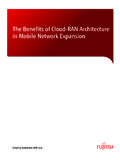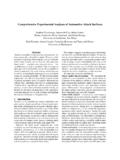Transcription of Cloud RAN Architecture for 5G - tid.es
1 WHITE PAPER. Cloud RAN Architecture for 5G. Cloud RAN. Architecture for 5G. A Telef nica White Paper Prepared in collaboration with Ericsson 1. WHITE PAPER. Cloud RAN Architecture for 5G. Executive Summary Increasing traffic demand, limited spectrum availability and mass adoption of mobile broadband are challenging the traditional ways to build cellular networks. In this new environment, mobile operators are seeking new ways to increase network capacity, coverage and user experience while reducing time to market for new services and reduce costs. To accomplish this, operators need to cost-effectively use all network assets, including multiple standards, frequency bands, cell layers and transport network solutions.
2 This means that, above all, cellular infrastructure must be flexible and support simplified deployment and management of increasingly heterogeneous radio access networks (RANs). At the same time, in the mobile packet core network, Network Function Virtualization (NFV) has emerged as a viable approach to increase network flexibility in order to, for example, reduce time to market for new services. Making use of open application interfaces and sharing of data centers enables a large number of applications and services to be provisioned cost-effectively over fixed and mobile broadband networks and for many device platforms. The question now is how operators can best make use of virtualization technologies in RANs while at the same time building cost-, spectrum- and energy-efficient networks that offer a seamless user experience.
3 There are major distinctions, however, between Cloud computing in the RAN. compared to the core network and service layer. For example, the bulk of the cost of a mobile network lies in the large number of distributed base station and antenna sites, as well as in the last-mile transport network links not in central nodes and sites. Consequently, the costs associated both with the central parts of the network and its distributed elements and last-mile links must all be taken into account for a cost-effective network evolution. Future Cloud RAN architectures will therefore exploit a combination of virtualization, centralization and coordination techniques, all of which interact with each other in a variety of ways within the network.
4 Cloud RAN will be composed of a mix of Distributed RAN, Centralized RAN and Virtualized RAN architectures, allowing for spectral efficient solutions over the transport infrastructure available. This paper outlines these Architecture options and identifies their key benefits and challenges. 2. WHITE PAPER. Cloud RAN Architecture for 5G. Table of Contents Introduction Mobile network capabilities are evolving quickly, continuously 1. Evolving the radio access network pushed by new requirements relating to latency, traffic volumes, data rates and need for reliable connectivity. 2. RAN Architecture evolution To efficiently meet future demands the LTE RAN Architecture will need to support improved resource pooling, capacity 3.
5 Future radio access network scalability, layer interworking and spectral efficiency over various transport network configurations. 4. Overview of RAN Cloud RAN architectures will support these needs by exploiting Network Functions Virtualization techniques and data center processing capabilities, as well as improved radio coordination 5. 5G Architecture design aspects and open for distributed as well as centralized RAN deployments. 6. Key 3. WHITE PAPER. Cloud RAN Architecture for 5G. 1. Evolving the radio access network Architecture Mobile broadband is approaching a point where cellular infrastructure originally designed for mobile telephony is a viable substitute for fixed broadband in many markets.
6 At the same time, the mass adoption of smartphones and other connected devices is increasing the need for speed application coverage, lower latency and greater capacity in mobile broadband networks. This evolution is being driven by both the evolution of 4G and the coming introduction of 5G, which will deliver a downlink user experience of 10-100 Mbps everywhere and 1-10 Gbps locally, with a latency of less than 1 ms. In essence, the main challenges for mobile network infrastructure to meet this need over the next three to five years will be to: manage large amounts of new spectrum, primarily on higher bands (>4 GHz) and then combined with existing bands, so that by 2020 a typical mobile network operator could have access to more than 100 MHz in five to ten bands.
7 Deploy new sites to support new use cases which may also require new business models;. and develop efficient hardware and software solutions that enable the speedy introduction of new services in a sustainable way, from both an energy and cost perspective. 5G use cases such as enhanced mobile broadband (MBB) (see Figure 1) may also drive the further evolution of the RAN Architecture . Figure 1. 5G Use Cases (taken from ITU-R [5]). In this paper we focus on the evolution of radio access network architectures towards 5G. For this purpose we analyze the high level requirements on the RAN Architecture associated to current 4. WHITE PAPER. Cloud RAN Architecture for 5G. Radio Access Technologies (mainly LTE) and envisaged future 5G technology.
8 Further, we review the different RAN Architecture options, ranging from the traditional Distributed and Centralized RAN architectures to new options enabled by Network Function Virtualization and improved transport network capabilities. Finally, we analyze how the new architectural options allow addressing the 5G needs. 5. WHITE PAPER. Cloud RAN Architecture for 5G. 2. RAN Architecture evolution drivers From a network Architecture perspective, the main options for LTE up to the present have been either fully distributed or fully centralized baseband deployment, each with its own pros and cons. In essence, the choice of Architecture is a tradeoff between: need for spectral efficiency and user experience, efficient utilization of equipment and sites, and cost and availability of last mile'-transport network connectivity.
9 These needs in turn drives the need for coordination (between cells and bands), centralization (of hardware), and virtualization (of software) that are discussed further next. Coordination Going forward it is anticipated that radio access networks will become more heterogeneous, composed of multiple layers with different cell sizes and bandwidths, which calls for a tighter interworking between technologies and cell layers to ensure a seamless use experience and maximum spectral efficiency. Such interworking, or radio coordination, can in LTE today be achieved in a distributed RAN. Architecture as well as in a centralized RAN Architecture . Radio coordination between cells and bands is becoming increasingly important to maximize spectrum efficiency and user experience.
10 Generally speaking, radio coordination mechanisms can be categorized as: 1. Mobility management (handover). 2. Traffic management (load balancing). 3. Interference management (interference control). 4. Joint reception and transmission 5. Carrier Aggregation 6. Dual Connectivity Centralization Centralizing base station processing has several advantages from operational, hardware and spectrum efficiency point of view. First, it simplifies network management, upgrades and troubleshooting due to less site visits. Second, it enables hardware resource pooling: thanks to statistical multiplexing an execution platform can perform the same tasks with less hardware or capacity.



